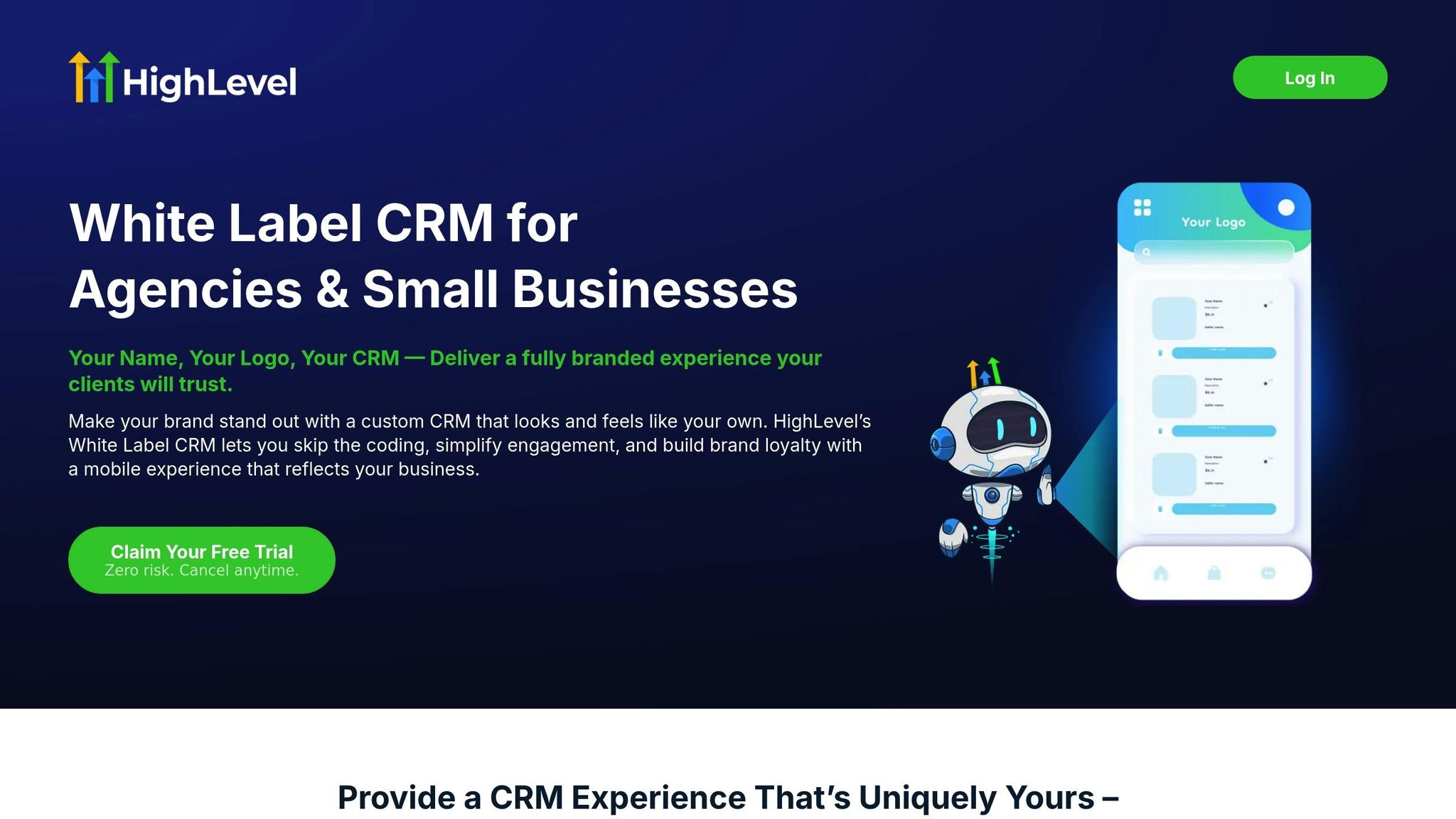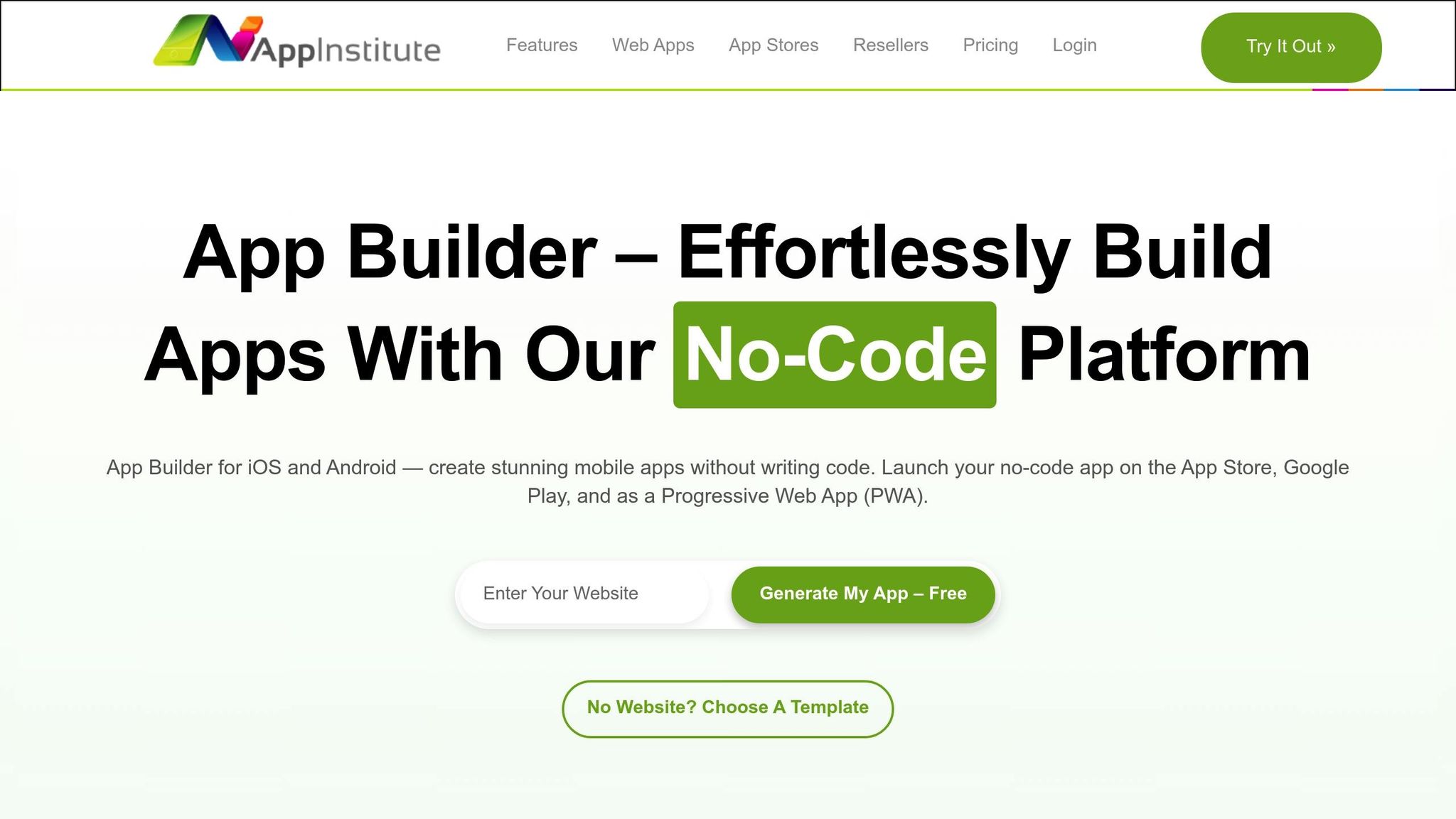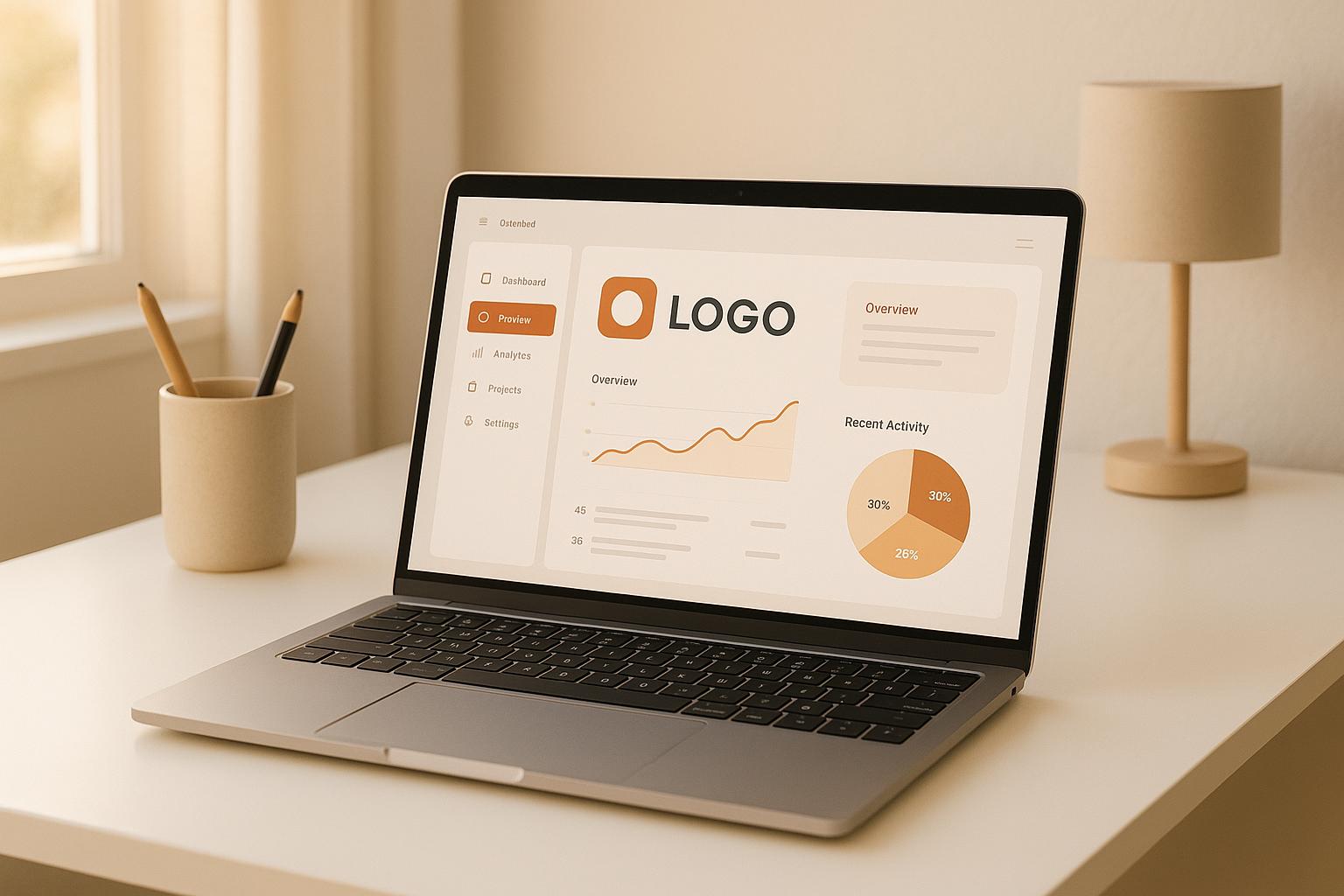Custom branding on white-label platforms is more than just adding your logo – it’s about creating a digital experience that reflects your business identity. This ensures trust, consistency, and a professional image across all customer touchpoints. Here’s what you need to know:
- Why It Matters: Generic designs can erode trust. U.S. consumers expect polished, branded experiences, especially in industries like finance and healthcare.
- Key Challenges: Inconsistent visuals, platform limitations, and compliance requirements can hinder branding efforts.
- Solutions: Use detailed style guides, leverage platform tools for customization, and maintain consistency across devices and channels.
- Pro Tips: Regularly update branding, test for accessibility, and ensure compliance with U.S. laws like ADA and CCPA.
Custom branding builds credibility and helps your business stand out in competitive markets. When done right, it creates a seamless experience that keeps your brand recognizable and trusted.
Custom Branding Basics
What Is Custom Branding
Custom branding takes a white-label platform and turns it into a personalized digital experience that feels entirely your own. It’s not just about uploading your logo – it’s about reshaping every aspect of the platform to reflect your brand’s identity.
"A white-label booking solution is a ready-made software platform that you can rebrand and present as your own."
– Trafft
This process starts with a solid foundation and allows you to tweak every visible element – think colors, fonts, messaging, domain name, and even the finer interface details. The goal? To make the platform unmistakably yours.
Custom branding isn’t just surface-level. While basic branding might involve swapping out a few colors or slapping on a logo, true white-label custom branding eliminates any traces of the original vendor. The result is a seamless digital experience where users never doubt that the platform was created by your business.
This level of customization lays the groundwork for understanding why U.S. businesses, in particular, place such a high value on tailored platforms.
Why U.S. Businesses Need Custom Branding
When it comes to custom branding, understanding the expectations of the U.S. market is key. American consumers are used to polished, professional digital experiences. They can quickly identify platforms that feel generic or cookie-cutter, and that lack of attention to detail can erode trust.
In a world where trust is everything – especially in industries like healthcare, finance, and professional services – a platform that fully embodies your brand sends a strong message of credibility. It reassures users that they’re dealing with a legitimate, accountable business.
In today’s competitive landscape, standing out is no longer optional. Custom branding transforms a basic tool into a powerful advantage, helping your business build trust and deliver the professional, high-quality experience that American consumers expect.
How to White Label the GoHighLevel App for Your Agency (Step by Step)


Common Custom Branding Problems
Businesses often encounter obstacles that undermine a polished brand presence. These challenges highlight the need for targeted solutions.
Mixed-Up Visual Elements
One major issue is inconsistent visual branding across platforms. This can happen when logos appear blurry or distorted, fonts deviate from brand guidelines, or colors vary between your website and app.
What starts as a minor oversight can quickly spiral. For instance, logos might get cropped on mobile devices, and brand colors can shift depending on screen settings. Typography often becomes chaotic when default platform fonts override your custom choices in certain areas.
These inconsistencies disrupt the user experience, making your business appear less professional. Users notice when elements don’t align or when your branding feels "off." In the U.S., where polished digital experiences are the norm, such details are crucial for building trust and credibility.
Platform Limits and Technical Issues
White-label platforms often come with technical restrictions that limit branding flexibility.
Templates can box you into rigid layouts that don’t align with your brand’s identity. You might struggle to adjust spacing, modify navigation, or restructure the flow of your platform to reflect your vision.
Domain and hosting challenges add another layer of frustration. Configuring custom domains can be tricky, with DNS setup often confusing for non-technical users. SSL certificate issues may lead to alarming security warnings, and subdomain restrictions might force you to use URLs that don’t align with your brand name.
Integration problems also arise. CRMs might not sync properly, payment systems can display third-party branding, and analytics tools may break when paired with custom elements.
Mobile responsiveness poses yet another hurdle. While your branding might look flawless on a desktop, it can fall apart on smartphones and tablets, requiring extra effort to maintain consistency across devices.
Meeting U.S. Compliance Requirements
Legal, accessibility, and data privacy rules add complexity to custom branding, creating potential risks if not handled properly.
ADA compliance is a key concern. Your branding must support accessibility features, ensuring color choices meet contrast standards, fonts remain readable for visually impaired users, and navigation works seamlessly with screen readers. Many businesses discover too late that their designs fail to meet accessibility needs, putting them at risk of legal issues. Balancing design integrity with compliance is critical for earning trust in the U.S. market.
Data privacy laws add another layer of responsibility. Privacy policies, cookie notices, and data collection forms must be clearly displayed and integrated into your branded interface. Regulations like the CCPA in California require specific disclosures, which can sometimes clash with your desired visual style.
Industry-specific standards bring additional challenges. Healthcare apps must adhere to HIPAA, financial services face strict disclosure rules, and educational platforms must comply with FERPA. These regulations often require adjustments that can interfere with your branding goals.
The real challenge comes when compliance requirements conflict with design preferences. For example, a clean, minimalist layout might need to accommodate disclaimers, terms of service links, and mandatory disclosures, cluttering your carefully planned design. Balancing these demands is no small task.
sbb-itb-539ae66
How to Do Custom Branding Right
Getting custom branding right requires a thoughtful and strategic approach. It’s all about maintaining consistency while navigating the limitations of various platforms. Here’s how to make it happen.
Creating Consistent Visual Design
The cornerstone of strong branding is a detailed brand style guide. This guide should cover every visual element your platform will use, including:
- Exact color codes (use hex values, not just color names).
- Specific font families with fallback options.
- Logo guidelines for different sizes and formats.
- Spacing requirements to ensure a clean, professional look.
Prepare multiple logo variations – horizontal, vertical, light, and dark versions – to suit different situations. Test these logos on mobile devices to confirm they appear sharp and consistent across all screens.
Typography is another critical area where consistency often slips. Go beyond just picking a primary font. Define clear rules for heading hierarchies, body text sizes, and line spacing. Don’t overlook secondary text like forms, buttons, or navigation menus – they’re just as important for a cohesive look.
When it comes to colors, consistency is key, but it’s not always straightforward. Colors can look different depending on the device or browser. What seems vibrant on your desktop monitor might appear dull on a smartphone. Test your color palette on a variety of devices and ensure it works well in both light and dark mode settings.
Lastly, create branded templates for customer communications. This includes everything from email headers to push notifications and in-app messages. These small details often get overlooked but play a big role in reinforcing your brand’s image.
Using Platform Tools for Better Branding
Once your visual design is consistent, you can take things further by leveraging platform tools to enhance your branding.
Start with custom domains. Instead of using generic platform URLs, set up your own branded domain. This not only looks more professional but also helps build trust with your users and improves SEO.
Explore the customization options offered by white-label platforms. Many allow you to go beyond basic design tweaks with features like CSS modifications, custom headers and footers, and flexible layouts. These tools help you move away from generic designs while maintaining stability.
Automation can also make a big difference. Use tools that automatically apply your brand elements to new content and maintain formatting standards across user-generated sections. This ensures your branding stays consistent, even when non-technical team members are making updates.
Choose platforms that integrate seamlessly with your CRM, email marketing, and analytics tools. These integrations help you maintain a polished, professional appearance across all touchpoints.
Mobile optimization is another area that deserves attention. Test every aspect of your branding – navigation menus, button placement, and content layout – on mobile devices. What works on a desktop screen often needs adjustments for smaller, touch-based interfaces.
Keeping Your Branding Current
Branding isn’t something you set and forget. It requires regular updates and attention to stay relevant.
Schedule quarterly reviews to monitor metrics like page load times, mobile responsiveness, and user engagement. This helps you catch and fix inconsistencies before they become noticeable to users.
Stay aware of industry trends and user feedback. While you don’t need to jump on every design trend, it’s important to ensure your branding feels modern and professional. If something starts to feel outdated, it’s time for a refresh.
When updating your brand assets, roll out changes across all platforms simultaneously. Whether it’s a new logo or an updated color palette, consistency is crucial. A coordinated update ensures your brand looks polished and avoids confusion.
Keep an eye on accessibility standards and compliance requirements. These rules evolve over time, especially in the U.S., so make sure your branding choices meet current standards and anticipate future changes.
Finally, document every branding decision and update. Clear guidelines ensure that as your team grows, everyone knows how to implement branding elements correctly. Establish approval processes for changes to maintain quality control and consistency.
How AppInstitute Makes Custom Branding Easy

For over ten years, AppInstitute has been breaking down technical barriers in white-label branding. With more than 100,000 businesses using its platform to build apps, AppInstitute knows exactly what U.S. companies need to create powerful, custom branding. By focusing on the essentials of branding, the platform provides tools that simplify and refine every aspect of the process.
Easy-to-Use Templates and Design Editor
AppInstitute’s drag-and-drop editor makes creating a branded app simple, even for those with no coding experience. You can tweak every design element – color schemes, images, logos, layouts, menu styles, and fonts – to match your brand’s personality.
The platform includes real-time previews to ensure your app looks consistent across devices. It also offers precise color customization options, allowing you to input exact HTML color codes or select from a visual palette. Industry-specific templates provide a great starting point, tailored to meet the needs of U.S. businesses.
Logo integration is hassle-free. AppInstitute provides tips on safe zones and optimal sizing to make sure your logo looks sharp on any screen. Uploading your main logo and splash screen images is quick, and built-in tools help position them for maximum impact.
Custom Domains and Branded Messages
For Progressive Web Apps (PWAs), AppInstitute supports custom domains, a critical element for maintaining a cohesive brand presence. Using your own domain not only strengthens brand recognition but also boosts your visibility in search engines.
Communication tools are built to reinforce branding efforts. Every plan includes unlimited push notifications, giving you a direct way to engage customers while showcasing your brand identity. Additional tools like message centers and news tickers allow you to send timely updates that align seamlessly with your brand’s voice.
Professional Branding Services
When the built-in tools don’t cover all your needs, AppInstitute offers advanced services to ensure your branding stands out. Their "Hire A Pro" service connects you with an expert app builder who can create a custom app tailored to your specific branding requirements. This is especially useful for businesses with detailed brand guidelines or unique design goals.
For agencies and consultants, the Reseller Program provides a way to deliver fully branded white-label solutions to clients. These services offer the flexibility to create a personalized app experience while providing dedicated account management to ensure every branding detail is handled with care.
Key Points for Custom Branding Success
Achieving success with custom branding on white-label platforms boils down to a few essential principles that help solidify your digital presence. The most important? Consistency across all touchpoints. Whether it’s your app, website, or marketing materials, everything – colors, fonts, logos, and messaging – needs to align perfectly. This uniformity ensures that your brand feels cohesive no matter where customers encounter it.
Once you’ve nailed consistency, take full advantage of the tools your platform offers. Features like drag-and-drop editors, pre-built templates, and advanced branding options can help you deliver polished, professional results without needing to start from scratch.
For more intricate branding needs, consider bringing in professional help. While DIY methods work for simple customizations, complex projects – like maintaining brand integrity across multiple platforms or adhering to detailed brand guidelines – are often better handled by experts. Their input can be invaluable for industries with specialized requirements or strict standards.
Think of custom branding as a continuous effort. Regularly audit your designs to spot inconsistencies and make updates that keep your brand fresh while staying true to its core identity.
Don’t overlook the technical details, either. Setting up custom domains, ensuring logos are properly sized, and using exact color codes can make a huge difference in presenting a polished and professional image everywhere your brand appears.
For U.S.-based brands, meeting accessibility standards is a must. Adopting mobile-first design principles ensures smooth performance on both iOS and Android devices while also complying with ADA regulations.
When done right, custom branding doesn’t just make your business look good – it builds trust, improves recognition, and drives engagement. These benefits often translate into better retention and higher conversion rates.
FAQs
How can I make sure my custom branding looks consistent across all devices and platforms?
When it comes to keeping your branding consistent across devices and platforms, it all starts with solid, detailed brand guidelines. These should clearly outline everything from your color palette and fonts to how your logo is used. Don’t stop there – include guidance on tone and messaging to ensure your brand voice stays consistent, too.
Templates can be a lifesaver for maintaining uniformity in your designs. They make it easier to stick to your guidelines and save time. Regularly reviewing your branding is also key – check that all elements, like logo placement, font sizes, and color schemes, are being applied correctly. For an extra layer of consistency, consider using tools or platforms designed to standardize branding across various channels. These small steps go a long way in creating a seamless and professional brand experience for your audience.
What compliance challenges do U.S. businesses face when customizing branding on white-label platforms?
U.S. businesses frequently face hurdles when customizing white-label platforms with their branding. Two major challenges include navigating regional data privacy and security laws like GDPR and CCPA, and properly handling intellectual property to steer clear of licensing conflicts.
To tackle these issues, staying informed about evolving regulations is a must. Alongside this, having solid legal agreements in place and fostering transparent communication with all stakeholders can make a big difference. Taking a proactive approach to compliance not only minimizes the risk of fines but also safeguards your brand’s reputation.
How can I ensure my custom branding stays current and resonates with users?
To keep your branding fresh and in tune with your audience, start by establishing clear and well-defined brand guidelines. These should reflect your company’s core values while staying mindful of shifts in your industry. Make it a habit to revisit these guidelines regularly to ensure they align with the latest standards and trends.
Stay connected with your audience by actively seeking their feedback. Use surveys, social media interactions, and reviews to gather insights into how your brand is perceived. This feedback can highlight areas that need improvement and help you understand what resonates with your audience. At the same time, keep an eye on industry trends and incorporate updates that fit your brand’s identity, ensuring you remain modern and competitive.
Lastly, don’t shy away from refreshing your branding elements when needed. Whether it’s tweaking your logo, updating your color palette, or refining your messaging, these updates can reflect both user input and market changes. Regular updates help your brand stay dynamic and relevant, all while staying true to what makes it uniquely yours.
Related Blog Posts
- Small Business App Development: Complete Guide
- Guide to Cross-Platform UI Component Libraries
- Ultimate Guide to Faster Drag-and-Drop App Development
- How No-Code Platforms Handle User Data Privacy
Last Updated on October 13, 2025 by Becky Halls

0 thoughts on “Best Practices for Custom Branding in White-Label Platforms”